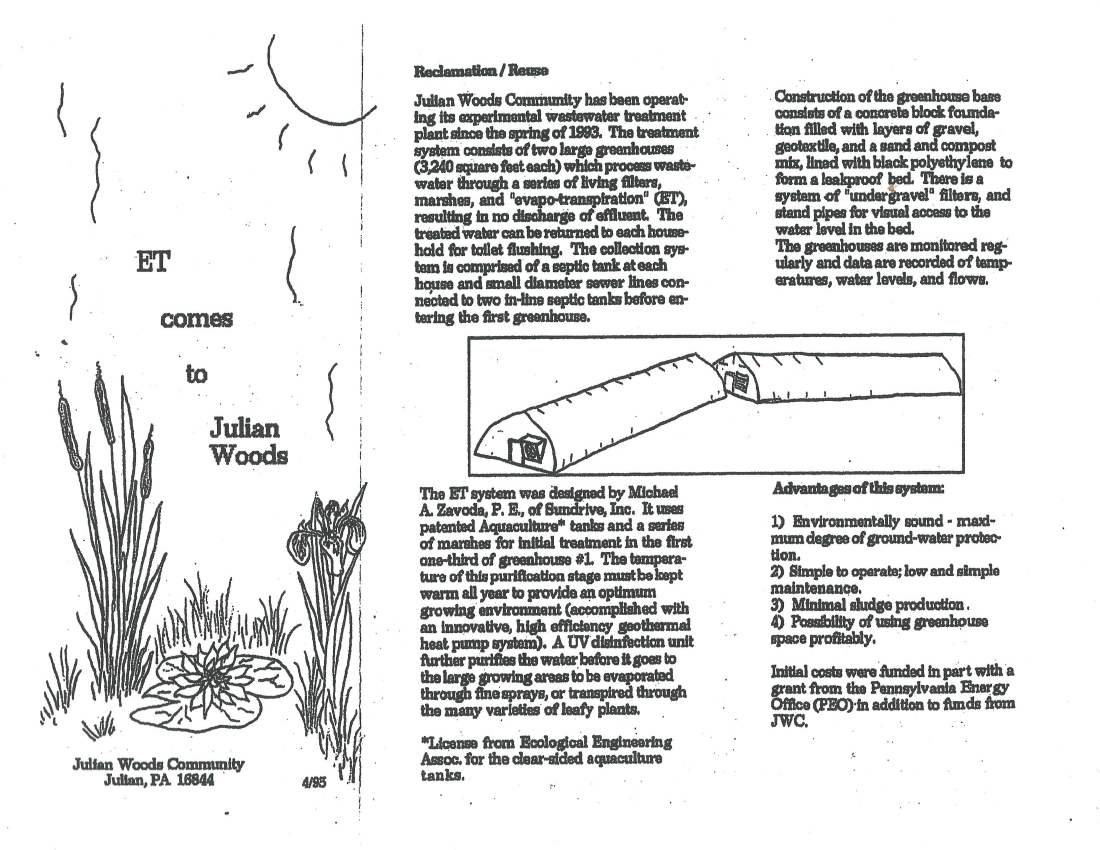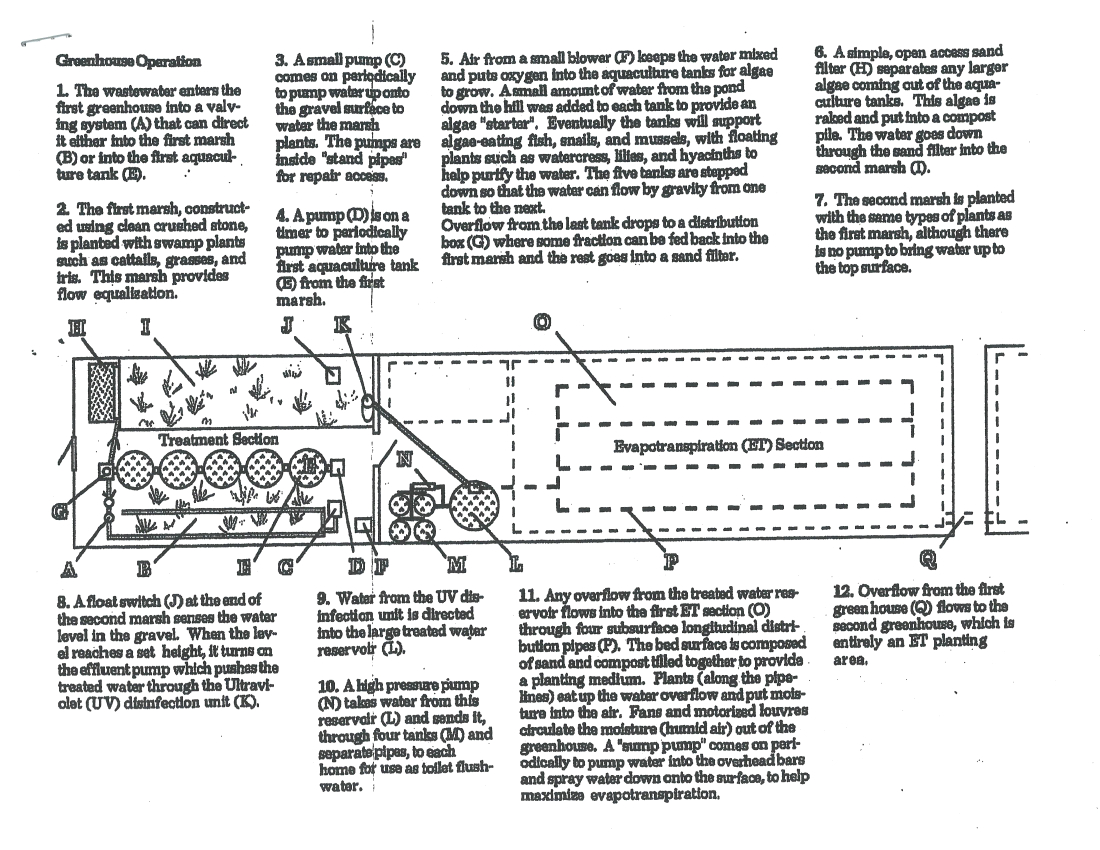Julian Woods Community (JWC) in Julian, PA invited their local garden club to tour their Living Machine greenhouse this fall. The Living Machine started its life in 1993 and is still going strong. JWC member Kent described how it all works!


The system reclaims, cleans, and reuses water for the community. It, also, provides perfect greenhouse conditions for Deb’s Flower Farm. The details of the Living Machine were given in a handout during the tour. You can find an image of the handout below. As it may be a little difficult to read, a copy of the text is at the end of this post. Thank you to Julian Woods Community for sharing this valuable information!


ET comes to Julian Woods
Reclamation / Reuse
Julian Woods Community has been operating its experimental wastewater treatment plant since the spring of 1993. The treatment system consists of two large greenhouses (3,240 square feet each) which process waste water through a series of living filters, marshes, and “evapo-transpiration” (ET) resulting in no discharge of effluent. The treated water can be returned to each household for toilet flushing. The collection system is comprised of a septic tank at each house and small diameter sewer lines connected to two in-line septic tanks before entering the first greenhouse.
Construction of the greenhouse base consists of a concrete block foundation filled with layers of gravel, geotextile, and a sand and compost mix, lined with black polyethylene to form a leakproof bed. There is a system of “undergravel“ filters, and standpipes for visual access to the water level in the bed. The greenhouses are monitored regularly and data are recorded of temperatures, water levels, and flows.
The ET system was designed by Michael A Zavoda, P. E., of Sundrive, Inc. It uses patented Aquaculture tanks* (*License from Ecological Engineering Assoc. for the clear-sided aquaculture tanks) and a series of marshes for initial treatment in the first one-third of greenhouse #1. The temperature of this purification stage must be kept warm all year to provide an optimum growing environment (accomplished with an innovative, high efficiency geothermal heat pump system). A UV disinfection unit further purifies the water before it goes to the large growing areas to be evaporated through fine sprays, or transpired through the many varieties of leafy plants.
Advantages of this system:
1) Environmentally sound – maximum degree of groundwater protection
2) Simple to operate; low and simple maintenance.
3) Minimal sludge production.
4) Possibility of using greenhouse space profitably.
Initial costs were funded in part with a grant from the Pennsylvania Energy Office (PEO) In addition to funds from JWC.
Julian Woods Community, Julian, PA 16844
Greenhouse Operation
1. The wastewater enters the first greenhouse into a valving system (A) that can direct it either into the first marsh (B) or into the first aquaculture tank (E).
2. The first marsh, constructed using clean crushed stone, is planted with swamp plants such as cattails, grasses, and iris. This marsh provides flow equalization.
3. A small pump (C) comes on periodically to pump water up onto the gravel surface to water the marsh plants. The pumps are inside “stand pipes” for repair access.
4. A pump (D) is on a timer to periodically pump water into the first aquaculture tank (E) from the first marsh.
5. Air from a small blower (5) keeps the water mixed and puts oxygen into the aquaculture tanks for algae to grow. A small amount of water from the pond down the hill was added to each tank to provide an algae “starter”. Eventually the tanks will support algae-eating fish, snails, and mussels, with floating plants such as watercress, lilies, and hyacinths to help purify the water. The five banks are stepped down so that the water can flow by gravity from one tank to the next. Overflow from the last tank drops to a distribution box(G) where some fraction can be fed back into the first marsh and the rest goes into a sand filter.
6. A simple, open access sand filter (H) separates any larger algae coming out of the aquaculture tanks. This algae is raked and put into a compost pile. The water goes down through the sand filter into the second marsh (I).
7. The second marsh is planted with the same types of plants as the first marsh, although there is no pump to bring water up to the top surface.
8. A float switch (J) at the end of the second marsh senses the water level in the gravel. When the level reaches a set height, it turns on the effluent pump which pushes the treated water through the Ultraviolet (UV) disinfection unit (K).
9. Water from the UV disinfection unit is directed into the large treated water reservoir (L).
10. A high pressure pump (N) takes water from this reservoir (L) and sends it, through four tanks (M) and separate pipes, to each home for use as toilet flush water.
11. An overflow from the treated water reservoir flows into the first ET section (O) through four subsurface longitudinal distribution pipes (P). The bed surface is composed of sand and compost tilled together to provide a planting medium. Plants (along the pipelines) eat up the water overflow and put moisture into the air. Fans and motorized louvres circulate the moisture (humid air) out of the greenhouse. A “sump pump” comes on periodically to pump water into the overhead bars and spray water down onto the surface, to help maximize evapotranspiration.
12. Overflow from the first greenhouse (Q) flows to the second greenhouse, which is entirely an ET planting area.
0 Comments